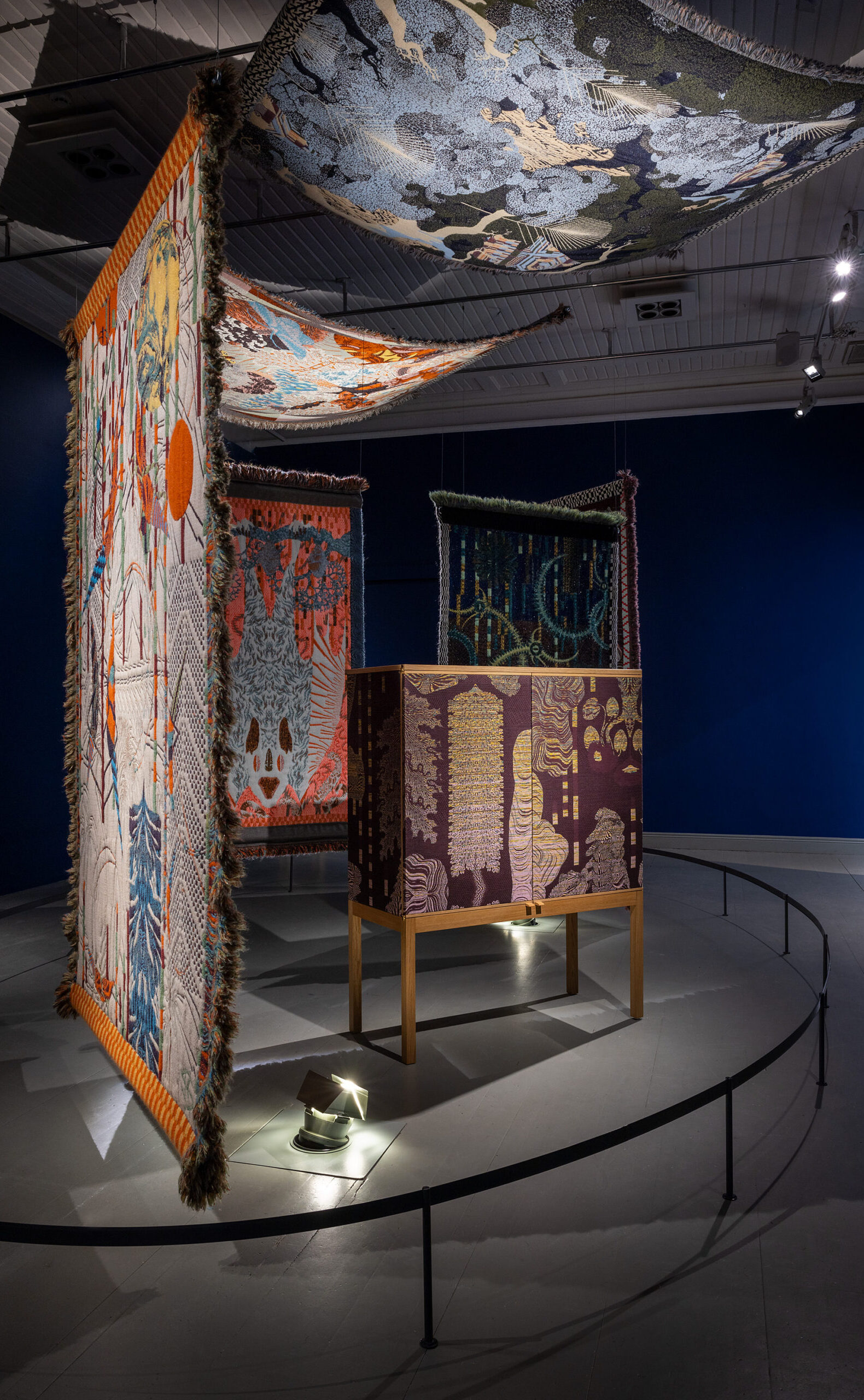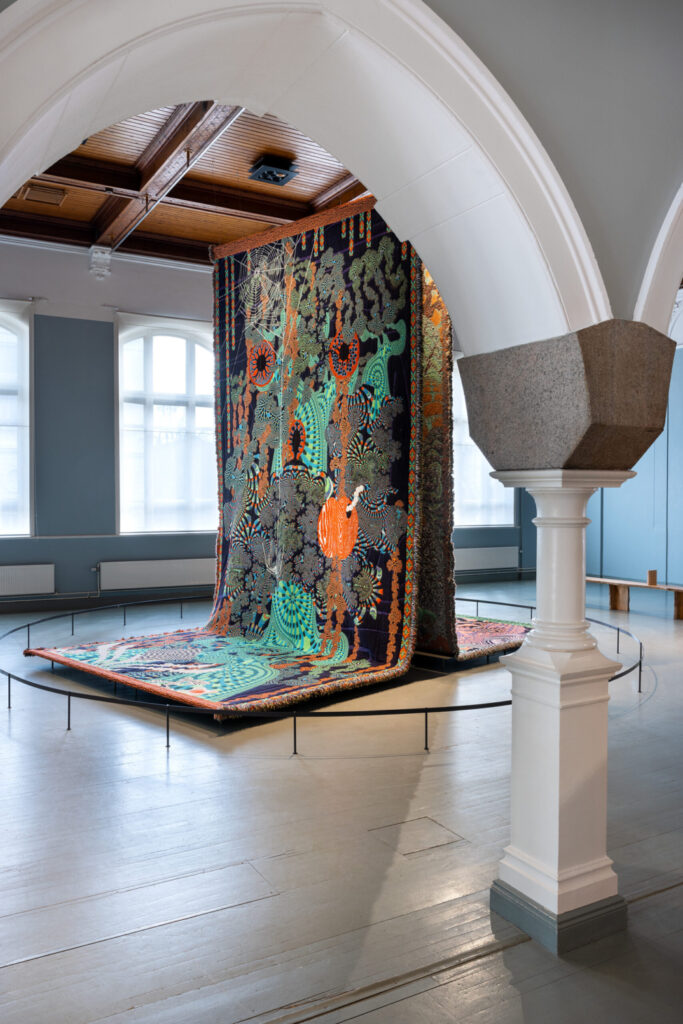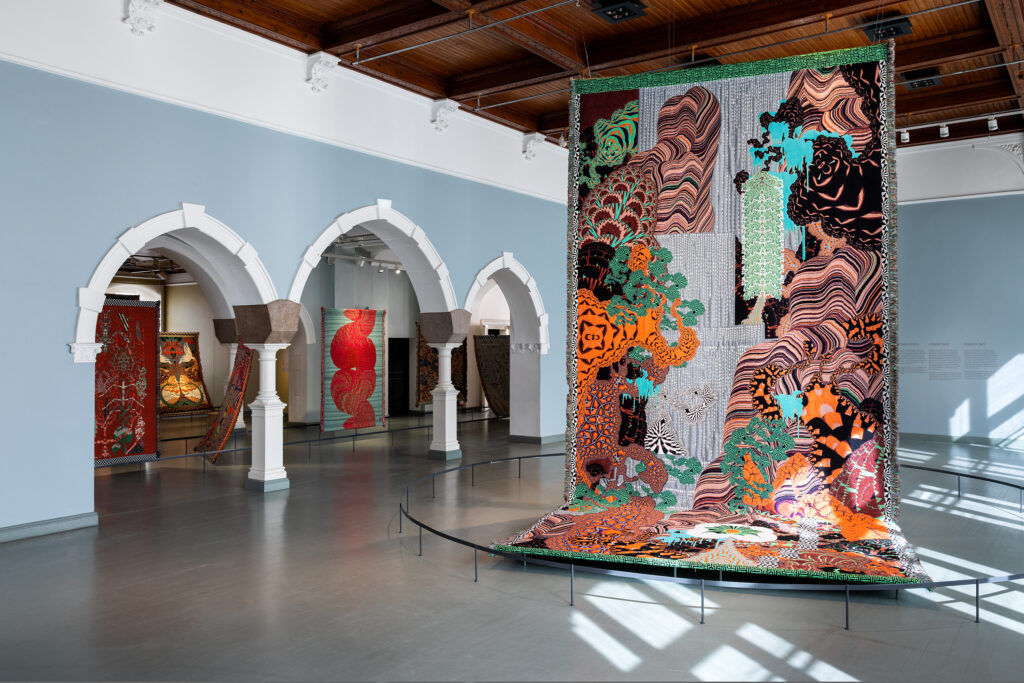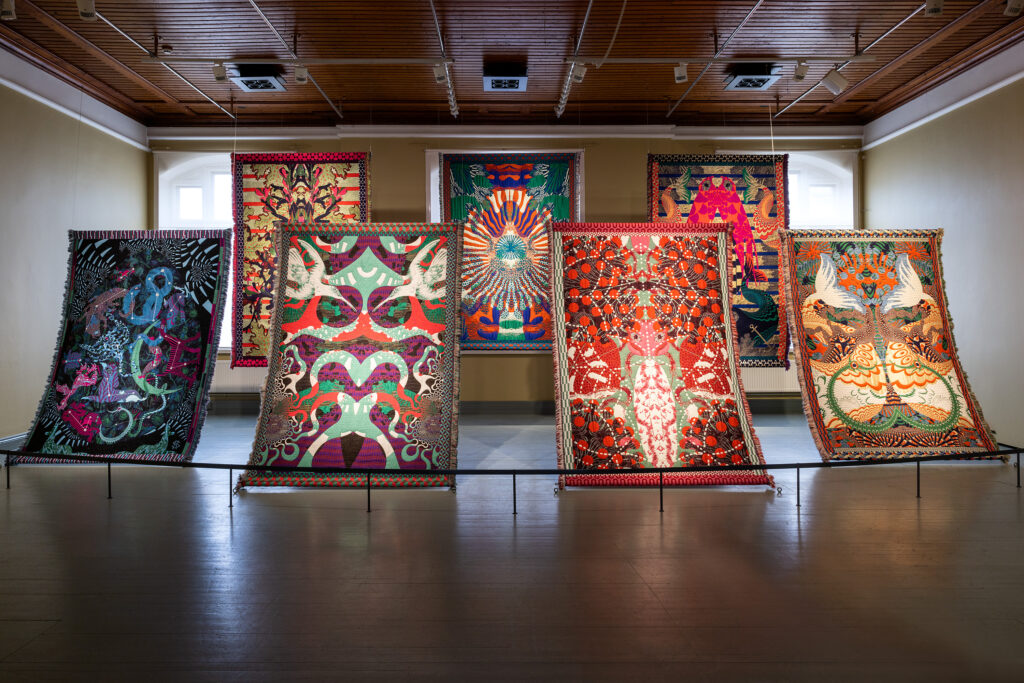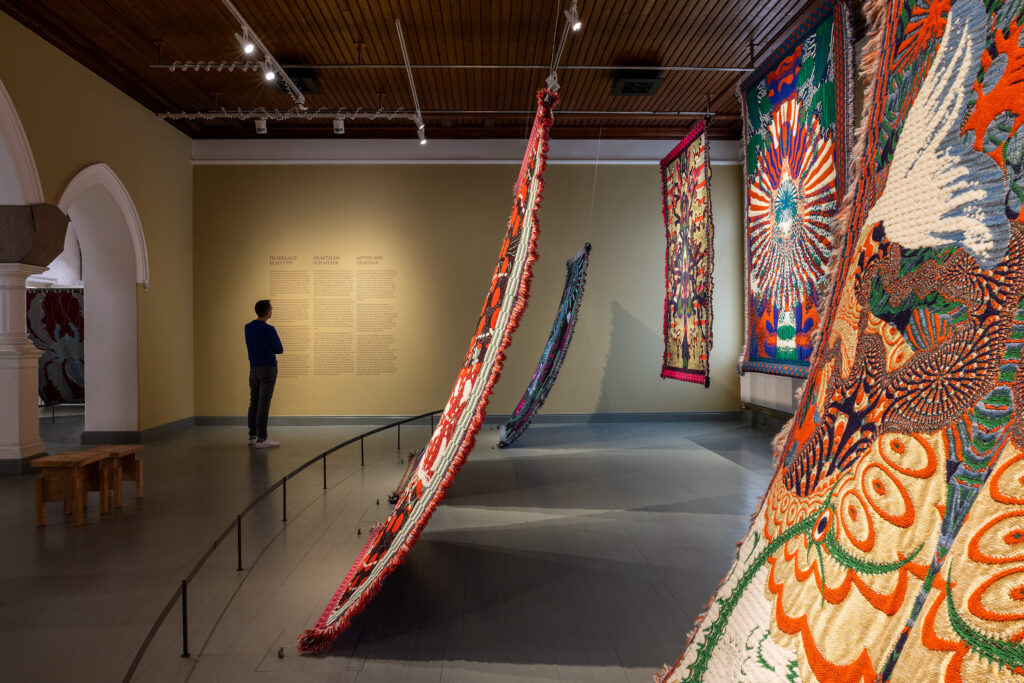In the Borderlands
Kustaa Saksi (b. 1975, Kouvola) is a multidisciplinary artist and designer. In the Borderlands looks back at an important chapter in Saksi’s career – his textile art, made between 2013–2023. In his tapestries, Saksi takes us on a journey through transitional, eerie spaces that emerge between the imagined and the real, sleep and wakefulness. Themes of his experience of migraines, universal experiences of dreams and hallucinatory visions, and mythical narratives reappear in Saksi’s work over the years. Saksi has always been intrigued by the human brain, especially its capacity to process sensory information differently and unexpectedly.
Originally trained as a graphic designer (Lahti Institute of Design), Saksi has worked extensively as an illustrator. Over the years, his illustrations have been commissioned by celebrated fashion houses such as Hermès, Ferragamo, Issey Miyake, and Marimekko. At the same time, he continued to develop an artistic practice in graphic storytelling, experimenting with different media and ways of expression – be it through pattern design, spatial installations, moving images, furniture or jacquard textiles. Saksi’s 20-plus years career has taken him around the globe. Currently, he lives with his family in Amsterdam, where his studio is located.
Kustaa Saksi’s abstract and psychedelic imagery communicates with the Design Museum’s building and the exhibition architecture by Lauri Johansson. Gustaf Nyström designed the museum’s Neo-Renaissance building in 1895.
Work: Käkkärä (2022). Basic information about this work can be found here Photo: Paavo Lehtonen
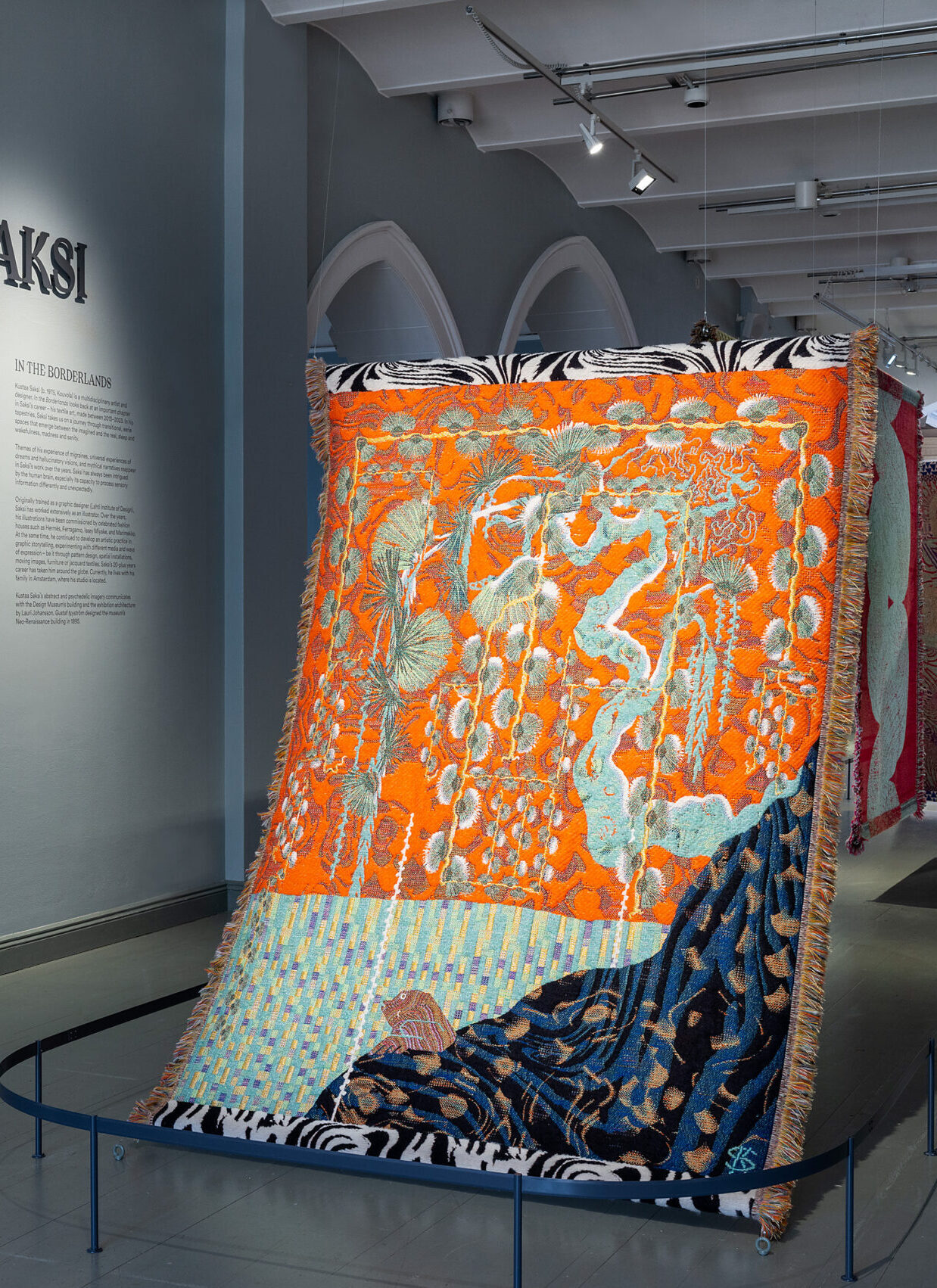
The Path of Collaboration
In search of a suitable medium to take his visual world onto a new path, Saksi discovered the three-dimensional nature of woven textiles when he first visited TextielLab in Tilburg, Netherlands, in 2010. A long process of learning, sampling, and experimentation followed, resulting in a collaboration that continues today. TextielLab is a workshop at the TextielMuseum in Tilburg, a southwest region of the Netherlands. TextielMuseum was established to honour the industrial past of Tilburg – the Netherlands’ textile capital, until the 1960s. Tilburg’s booming wool fabric industry rapidly grew after World War II but collapsed soon after. The museum has been occupying the premises of a former textile factory since 1958.
In 2005, TextielLab opened its doors to designers and artists interested in textile artisanship and craft. TextielLab operates as part of the museum’s strategy to nurture and sustain textile heritage and promotes textile-making know-how in the Netherlands. TextielLab offers the education and expertise of textile developers and yarn specialists for the makers who work with high-end fabrics. It also facilitates the production, assists with grant applications, and supplies workspaces for artists and designers.
Work: Arachne's Web (2013). Basic information about this work can be found here Photo: Paavo Lehtonen
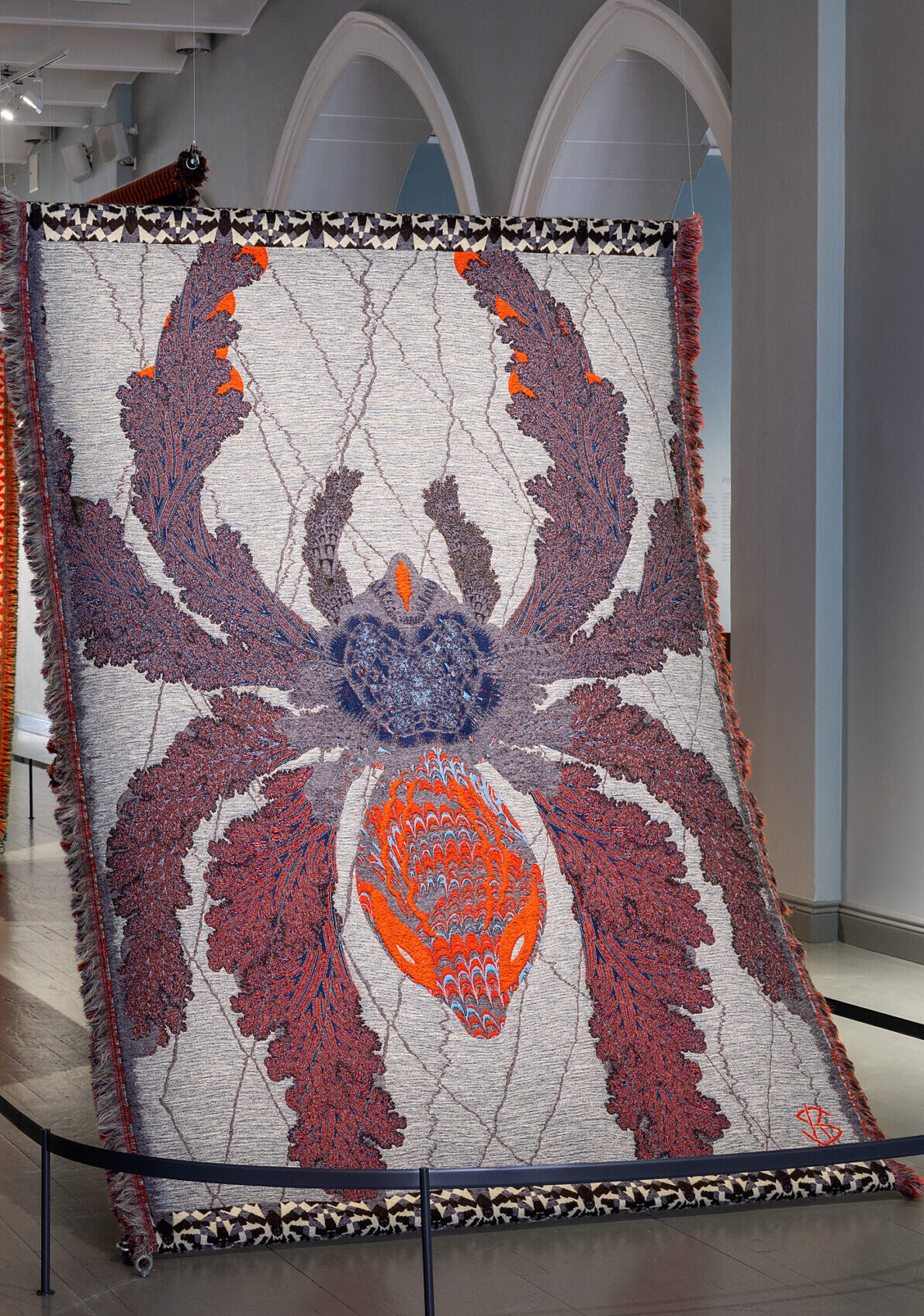
Migraine Metamorphoses
Kustaa Saksi has suffered from migraines since he turned seven. Using migraine as a theme for his work was a step for Saksi towards overcoming a fear associated with the condition, trying even to find beauty in it. Aura, Attack, In Full Bloom, and Aftermath – titles of the works from the First Symptoms series – refer to different phases of a migraine. The bizarre patterns come from Saksi’s own sensations caused by migraines. Textile material brings a special dimension to the patterns. The soft and soothing materials mitigate the painful subject matter.
Migraines are a partially hereditary neurological disorder resulting in strong, repetitive headaches, sometimes leading to partial disability. Only a third of people with migraine headaches experience sensory, visual or motor disturbances called auras. Visual auras usually come in the form of flashing zigzag lines, greying of the visual field (scotoma), or object distortion. These are attributed to neural activity in the area of the brain that is responsible for processing visual information.
Works from the series First Symptoms: Archetypes and Attack (2018). Photo: Paavo Lehtonen
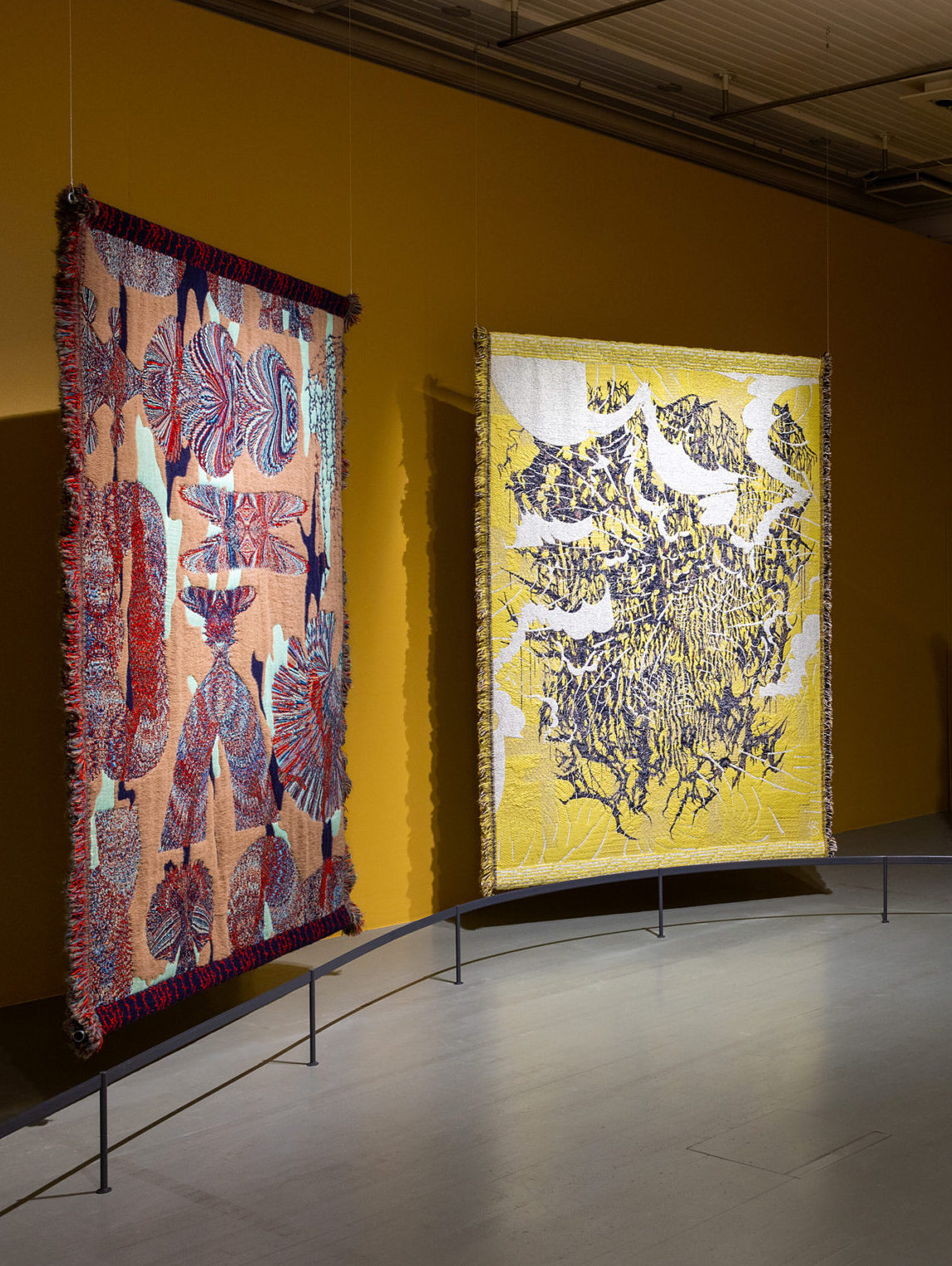
The Code
The documentary film The Code portrays Saksi´s work and life, capturing an intimate glimpse of the artist’s practice and perception of the world. In the film, Saksi ponders the question of detachment from a particular cultural context as a Finn who once was based in France and nowadays lives in the Netherlands, working in a thoroughly global field. The documentary also features Taito Saksi, the son of the artist. Through his son, Saksi reflects on his inherited condition of migraines.
The documentary is a collaboration between filmmaker David Verbeek (b.1980) and Kustaa Saksi. Verbeek is a Dutch film director and visual artist based in Taiwan. His works span from art house feature films to short indie documentaries and computer games.
Photo: Paavo Lehtonen
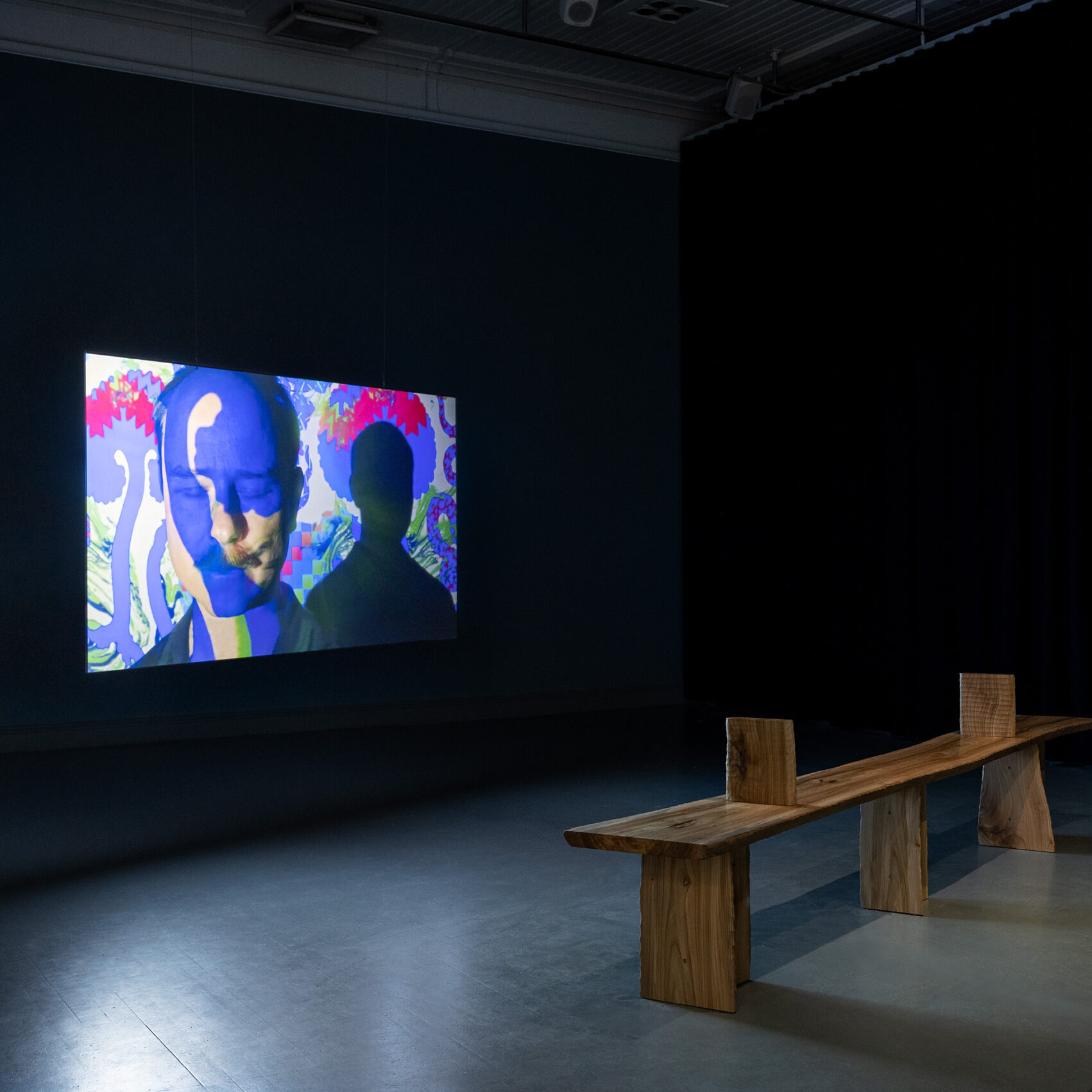
Jacquard technique
Kustaa Saksi started his experimentation with jacquard-woven textiles twelve years ago. He likes the endless possibilities of working with yarns – which also comes with challenges. Usually, after an initial period of research and ideation, Saksi draws an image using a computer, a brush or a pen, or by composing a collage. When the sketch is ready, he takes it to Tilburg, where he presents his idea to the TextielLab staff. Saksi works in close collaboration with senior weaving developer Stef Miero. With the help of software, each figure and colour in the sketch is translated into a specific texture before the weaving process can start. The result is a combination of complicated layers of bindings. Saksi spends many days in the workshop – following and supervising the weaving process, searching for the optimal fibre materials and making textile samples to achieve the proper structure and feeling.
In jacquard textiles, the pattern is woven with yarn into a textile rather than embroidered, printed, or stamped onto the fabric. The Jacquard loom, invented by Joseph-Marie Jacquard at the beginning of 19th century France, made the automatic production of intricate and complex patterns possible. In fact, the historical Jacquard loom, working with punched cards, was a model for modern computers. Today, the computer-controlled jacquard weaving process allows for quick changes. Saksi has sometimes called his process “action painting with warp and weft”.
Woven textiles contain sensorial information accessed by touch. The qualities of different yarn and the structure of the weave can communicate somatic, tactile impressions: the coldness of metal, the softness of mohair, or the smoothness of silk. For Saksi, the choice of material and colour is often based on what kind of feeling he wants it to convey. The decision may come after a lengthy reflection or intuitively at the outset.
Photo: Paavo Lehtonen
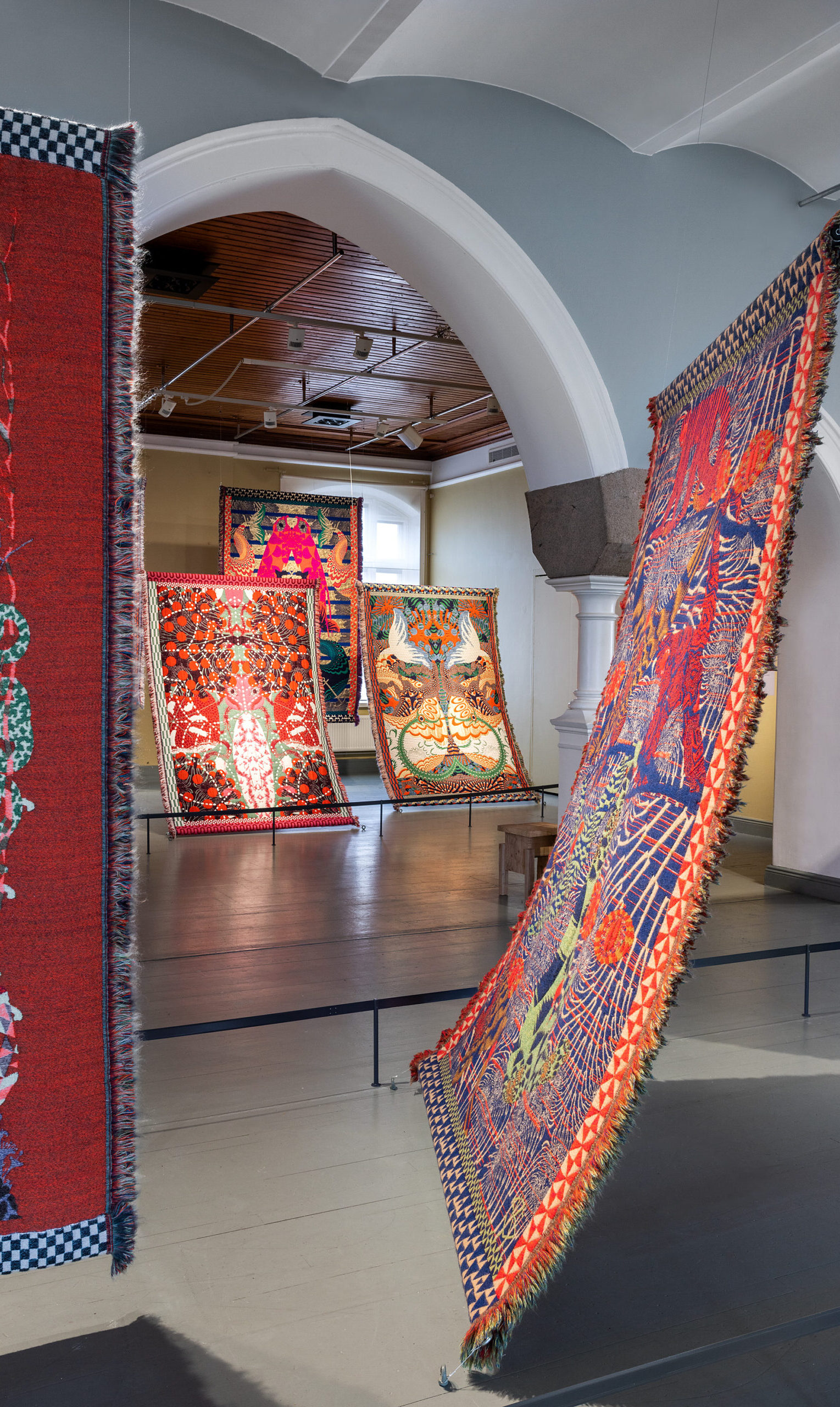
A World in Waiting
A World in Waiting is an artistic vision of a landscape 2000 years from now, created by Kustaa Saksi and IC-98. A World in Waiting imagines a possible future set in the year 4017, where the planet’s climate has warmed considerably, sea levels have risen, and humanity is long gone. The work envisions a place by the Arctic Ocean, where the Svalbard Global Seed Vault is currently located. The Seed Vault is humanity’s backup storage of food crop seeds in Spitsbergen, Norway.
In the tapestry, seeds from around the world have sprouted into lush meadows. The actual seeds of the depicted plants are woven into the fabric, bringing the potential future inhabitants of the planet, who are waiting to be born, into our presence. IC-98 conducted research for the project and selected the plants that are forecasted to thrive in the significantly warmer climate of the future. The seeds were sourced from the Natural Resources Institute of Finland. Kustaa Saksi was responsible for visualising and translating the idea into a textile form.
This contemporary tapestry was inspired by the tapestries collection housed at the Victoria and Albert Museum in London. It refers to a millefleur (from French: “a thousand flowers”) style that was popular in European tapestries during the late Middle Ages and Early Renaissance. The millefleur style featured a background of multiple dispersed flowers and plants, as if growing through the grass, and was often designed as an irregular pattern.
IC-98 (Patrik Söderlund, b. 1974, and Visa Suonpää, b.1968) is a Finnish artist duo. They are known for animated film installations, which combine classical drawing and digital effects, often depicting landscapes shaped by nature and technology.
A World in Waiting (78°14'08.4"N 15°29'28.7"E) / Photo: Paavo Lehtonen
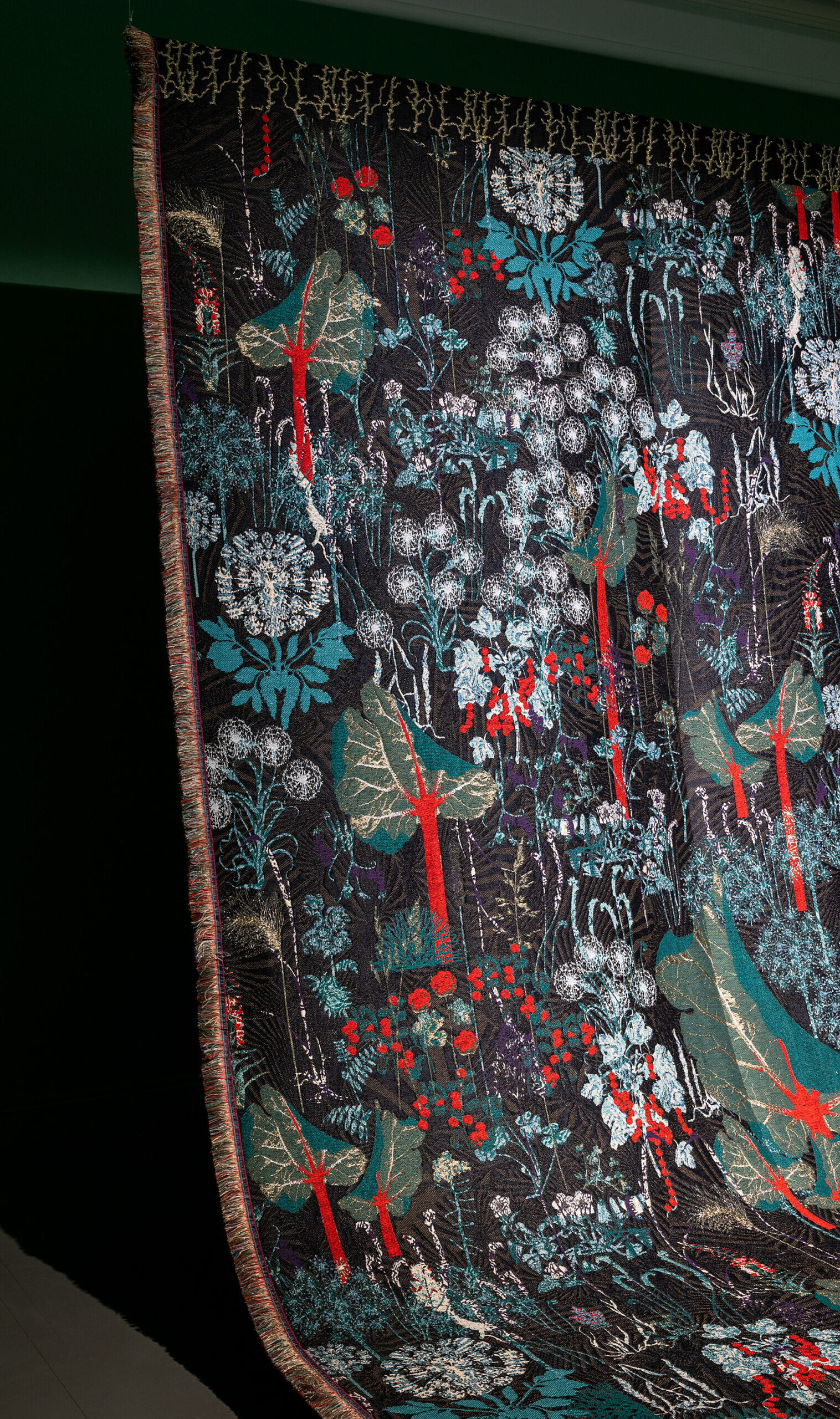
Monsters and Dreams
Kustaa Saksi’s first tapestry series Hypnopompic is based on experiences of hypnopompic hallucinations. A family member shared these experiences with Saksi, who found the stories fascinating and began writing them down. Hypnopompic hallucinations occur in the state between sleep and wakefulness. For some people, these states are accompanied by sleep paralysis and vivid hallucinatory visions in the form of animals, insects, different creatures, or geometric forms. They are often alarming or frightening. A unique characteristic of hypnopompic hallucinations, as opposed to dreams, is that the person frequently feels mentally and physically trapped in the experience despite being awake.
As in many of Saksi’s works, stories in the Hypnopompic series were only a starting point for creating an image. The outcomes were purposefully not repetitions but Saksi’s interpretations of someone else’s visions. Saksi describes them as “organised chaos”. The visual elements are influenced by ornamentation from numerous sources: zoological and botanical illustrations, op-art that is using optical illusions, and psychedelic imagery.
Artists, especially surrealists, often tapped into dreams to uncover subconscious associations between images, words, and meanings. Saksi later explored the liminal, borderline states between dream and wakefulness in the mini-series Reveille (English: “awakening”). In his other series Woolgathering, the theme is the fictitious nature of dreams, where the distinction between reality and illusion becomes blurred. The term “woolgathering” refers to daydreaming.
Information about the artworks in this room can be found here Photo: Paavo Lehtonen
